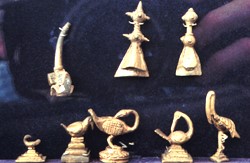Jan 25, 2016
Metal Casting in Ghana
Metal casting in Ghana
The Akan have a rich tradition in metal casting. Brass, copper, gold and iron have been the major metals with which Akan artisans shaped their tools for hunting and war, farming and domestic use, personal adornment, and for use as money. Archaeological evidence from the Begho in the Brong Ahafo Region indicates the presence of iron smelting in the area in the first millennium AD. The work of various archaelogists, notably Oliver Davies and Merrick Posnansky, has shown that smelting was once extensively carried on in parts of of the Akan area. Changes which occurred through the growth of nucleated market centers, and through long distance trade with middle Niger towns such as Jenne resulted in technological innovations in copper and brass casting, and the exploitation and smelting of gold. Warren (1975) hypothesizes that Bron, as the first and northernmost Akan centralized state, must have passed on some of these technological developments to some of the latter-day Akan states (e.g., Asante) that came after Bron. Probably the most common Akan objects cast in brass were gold weights, spoons, kuduo and forowa (so-called "grease containers"), and jewelry.
The casting of brass, silver, copper, and gold appears to have been regarded among the Akan as an occupation entirely distinct from that of the blacksmith. Blacksmiths produced items such swords, knives, matchete, agricultural tools (e. g., axe and hoes) and traps, and door hinges and locks. The goldweights of the Akan are as significant testimonies of the rich gold deposits of West Africa. They were used for measuring gold dust, which was circulating as currency in Ghana and Ivory Coast among the Akan from the 15th until 1912 (in Ghana), in everyday activities – in markets, royal treasuries, and for payments of state taxes and tolls. The royal courts of the Akan people were reportedly the most splendid in Africa. Oral tradition and iconography in Akan works of art are very closely connected. Verbal and visual symbolism tells stories or proverbs. Imagery of royal power on court ornaments carry out messages that helps keep the balance and continuity within the society.
FOROWA AND KUDUO
Forowa and kuduo are often confused with each other in the literature on Akan art. Forowa was made from sheet brass while kuduo was cast by melting brass through the lost wax process. Forowa and kuduo have functional and construction distinctions. The first, forowa, is made from hammered, or sheet, brass; its uses are chiefly domestic and personal, among them the storage of shea butter, a vegetable fat used as a cosmetic, as food, and as fuel. The second, kuduo, is made from cast brass. Its uses are mainly ceremonial and ritual, such as for sacrificial offerings, in newborn rites, female puberty celebrations, twins festivals, royal purifications, and funerals. Often filled with gold dust, gold weights, pearls, or other precious items, kuduo was associated with rituals related to the soul and was often buried with the body of the deceased person. The designs on forowa and kuduo are from the large inventory of Akan symbols found in gold weights, wood carvings, architecture, kente and adinkra cloths.
SWORDS
Blacksmiths fashioned agricultural tools and military equipment from iron. Agricultural tools included the hoe, cutlass (machete), knife, axe, and digging tools. Military equipment fashioned by the blacksmith included the spear and the sword - akofena. The akofena incorporates several symbols that relate to leadership. Some of the akofena was gilded with gold leaf and are embossed with various symbols (abosodee).
GOLD WEIGHTS
Gold weights - abrammoo, cast from bronze or copper using the cire perdue method, served the basis for denominating gold dust as money. These weights were not only valued aesthetically, but they were also valued as the depository for certain aspects of the Akan knowledge systems as they served as visual markers for recalling among other things proverbs, historical events, or everyday expressions.
GOLD WEIGHTS IN AKAN MATHEMATICS
Some gold weights depict the mathematical knowledge of the Akan. The various geometric designs as well as the everyday use of the weights as counter-balances attest to some aspects of the Akan mathematical acumen. Some weights were used as fractions and some were used as counters in calculations that involved numbers in the millions.
JEWELRY
Among some ethnic groups especially the Akan of Ghana, traditional jewelry was made of precious metal gold, probably due to the abundance or otherwise of gold in the land (Meyerowitz, 1949). The use of traditional jewelry in the cultural context of the Ghanaian is more than an adornment item. It is a visual representation of history, belief and political thoughts of a people. Each of the symbols in jewelry are denotes from historical events, individual achievements, proverbs, philosophical concepts, oral literature, moral values, social code of conducts, human behavior and certain attributes to plant and animal life (Meyerowitz, 1949).

